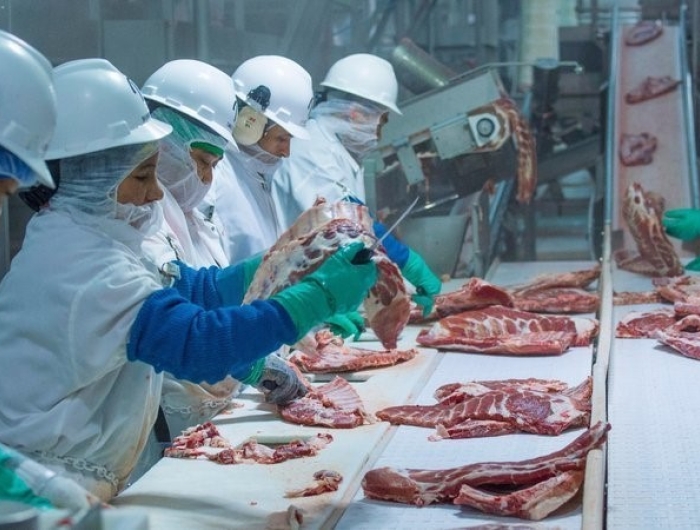COVID-19: still an occupational illness

Beyond the Curve: Dr. Peter Lurie's COVID-19 Blog
See all Beyond the Curve posts.
One of the first Beyond the Curve blog posts described the disproportionate concentration of COVID-19 cases in occupational settings like healthcare and meatpacking. Here we are a year later, and it’s still true. Kaiser Health News has estimated that at least 2,900 health-care workers died from COVID-19 in 2020, and at least 249 workers died from exposures in meat and poultry processing facilities.
The situation is improving, belatedly, in both industries. But no one really knows, of course, because of shoddy record-keeping practices. At one (of many) low points in the Trump administration pandemic response, the Occupational Safety and Health Administration actually instructed employers that they need not record COVID-19 cases among their employees—even in health care and meatpacking—as work-related. After a barrage of criticism, the agency was forced to backtrack.
Around that time, Trump also issued an Executive Order forcing meatpackers back to work on the ground that the clear risks to worker health were justified in the face of impending meat shortages—shortages that never materialized (our meat exports actually increased).
All this and more was laid out by David Michaels, who led OSHA during the Obama administration, at a hearing before the Subcommittee on Workforce Protections of the House of Representatives Committee on Education and Labor last week. (Disclosure: David is a close friend and sometimes co-author of mine.)
I’ll focus on just two of his many points.
First, he testified that “For many months it has been clear that transmission through inhalation of small aerosol particles is an important and significant mode of SARS-CoV-2 virus transmission.” But the Centers for Disease Control and Prevention (CDC) has focused primarily on relatively large respiratory droplets which are believed to not travel much beyond 6 feet and to fall to the ground quite rapidly. Aerosols, on the other hand, stay aloft longer and can travel further. Clearly there is a continuum of particle size and behavior between aerosols and droplets, but the consequences of the emphasis on droplet exposure are not merely theoretical, particularly in workplaces where workers may toil elbow-to-elbow, sometimes without adequate personal protective equipment (PPE).
To mitigate these risks, Michaels reached back to the basics of occupational health—indeed, he found them on CDC’s own webpages where the National Institute for Occupational Safety and Health, a part of CDC, describes a “Hierarchy of Controls.” (I first heard about this hierarchy when I was a student in Michaels’s Occupational Health summer program back in 1983. Ouch.) The best way to prevent the dissemination of a workplace pathogen, according to the hierarchy, is to prevent infected persons from entering the workplace (“elimination” in the hierarchy lexicon). Easier said than done, when a substantial fraction of infected patients is asymptomatic. And destined to fail when you force workers back to work without adequate PPE and incentivize them to work sick by not guaranteeing adequate paid sick leave.
Lower in the hierarchy are “engineering controls”: mitigating actions that are passive (requiring no specific actions) from the worker’s perspective. In the setting of COVID-19, that means adequate ventilation and/or portable air cleaners equipped with High Efficiency Particulate Air (HEPA) filters to remove infectious aerosols.
Social distancing, often honored in the breach in crowded meatpacking plants, is next in the hierarchy as an “administrative control.” By the way, those plexiglass dividers in meatpacking plants—another administrative control—don’t work.
At the bottom of the hierarchy sits “personal protective equipment,” in part because it places a burden upon workers and in part because it is less likely to be effective than the aforementioned measures. But even here workers are getting short shrift, as they often use less effective cloth and surgical masks, despite the demonstrated superiority of N95s, which protect against both aerosol and droplet exposure. (Cloth and surgical masks, or a combination of the two, may be adequate for non-workplace settings.)
Michaels’s second main point derives from his first: the government has failed abjectly in its role in promoting ventilation, social distancing, and N95s in high exposure settings like hospitals, nursing homes, and meat and poultry plants. Although Michaels’s OSHA was working on a standard to prevent infectious diseases in the workplace, the Trump administration soon consigned that to the scrap heap. And it repeatedly rejected calls, including from the Center for Science in the Public Interest, for an Emergency Temporary Standard (ETS) to protect workers during the pandemic, opting instead for a voluntary approach and a very limited number of fines that were so low that industry more likely viewed them as proof that they were better off not taking meaningful protective action.
The Biden administration has promised an ETS. Let’s hold their feet to the fire. The suffering the workers of this country have already endured due to government and industry abdication demands nothing less.
Contact Info: Contact us at cspinews[at]cspinet.org with questions, ideas, or suggested topics.

